Sino-Japanese War shipwreck discovered in Zhuanghe Area, Dalian, Liaoning
From July to September in 2018, a joint archaeological team consisting of SACH's National Center of Underwater Cultural Heriatge , Liaoning Provincial Institute of Cultural Relics and Archaeology and Dalian Municipal Institute of Cultural Relics and Archaeology, carried out special survey on the iron sunken wreckage remain. And finally the iron shipwreck was identifies as the famous ship of Beiyang Fleet named “Jingyuan”, sunk by the Japanese navy in the Sino-Japanese War during 1894-1895.
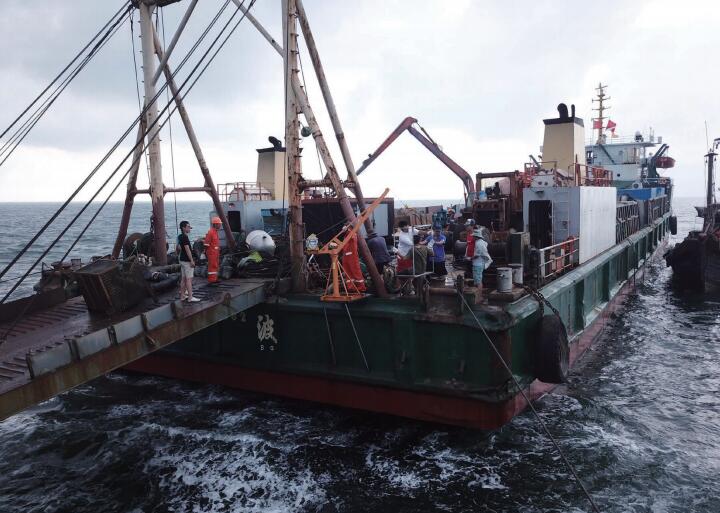
The work platform scence
According to scientific analysis, survey work aims to find out nameplate on the starboard. After more than 20 days of continuous sand extraction works, Two Chinese characters “Jing” and “yuan” were found on a plate 5.5m under the sand, allowing the team to confirm that it was the wreckage of the Jingyuan ship. Then, other important parts of the ship were dissected by archaeological team. Several parts from ship including stempost, anchor chain, porthole, hanging ladder, cinder exhaust port and so on were discovered and confirmed. And a number of significant cultural relics from shipwreck are uncovered, too.
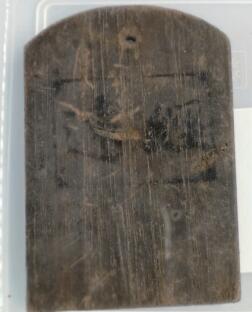
Tablet with its name Jingyuan
According to archaeological works, it’s known that the wreckage is turned upside down on the sea floor. The bow of the ship heads northeast. From bow to stern, the ship is tilted 2~3°. The whole shipwreck is about 80m long and 12m wide in residue. The maximum buried depth of the wreck under the sand is 6.4 meter. “Jingyuan Ship” has about 3-meter-high living cabin, 2-meter-high bulwark of the deck and shipborne weapons on the deck. More than 5-meter-long body of ship has been survived. Thus, its preservation state is far better than that of “Zhiyuan Ship”
From this survey, more than 500 pieces of various kinds of artifacts were found, the material including iron, wooden, cooper, lead, glass, porcelain, leather and so on. There are components of the ship, such as furnace, gaff, porthole, cabin door, iron bunker lining woods and etc. Weapons contain bullets of Mauser rifles, bullets of revolvers, 37 mm artillery cannon balls, 47 mm artillery cannon balls and so on.
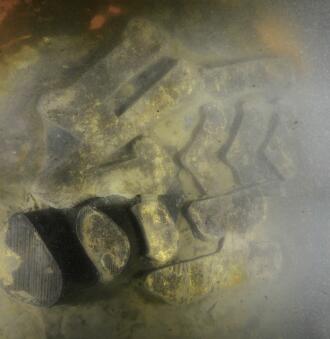
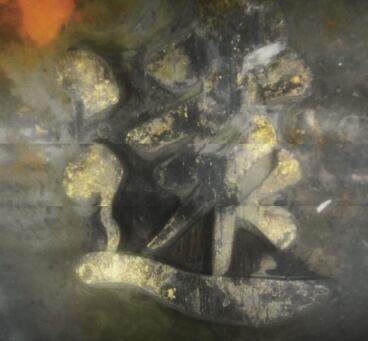
The Chinese Character of Jing and Yuan
Repairing tools include files, wrenches, screwdrivers, punches and etc. Personal goods have shoes, leather belts, tobacco pouch and etc. Besides, there are 53 mm Grunson cannon balls and 120 mm cannon ball igniter and so on being discovered in the remains, which are not documented in factory file of “Jingyuan Ship” and are probably urgently added weapons in order to improve firepower of stern right before the War.
First and for most, the discovery of “Jingyuan Ship” resolves controversy regarding sinking place of “Jingyuan Ship”. Before this, Dalu Island, Zhuanghe Area and Haiyang Island and etc. all have been predicted to be the sunken locations of “Jingyuan Ship”. With the find of nameplate of “Jingyuan Ship”, it’s sure that “Jingyuan Ship” was sunk in the south of Old Man Stone in Zhuanghe Area.
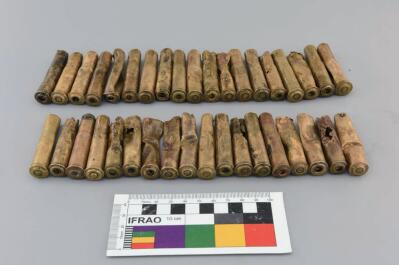
The Bullet
Survey of “Jingyuan Ship” is another important achievement after the discovery of “Zhiyuan Ship”. Its nameplate is the only one of Beiyang Fleet being found so far, and the materials, technologies and installation methods are figured out for the first time. The discovery provides rich materials for researches on history of world navy ships. Further improvements on underwater archaeological survey of shipwrecks of Beiyang Fleet play significant role in enhancing researches on modern Chinese history, development history of Chinese navy and history of world naval war and so on. (Translator: Ma Huanhuan)

